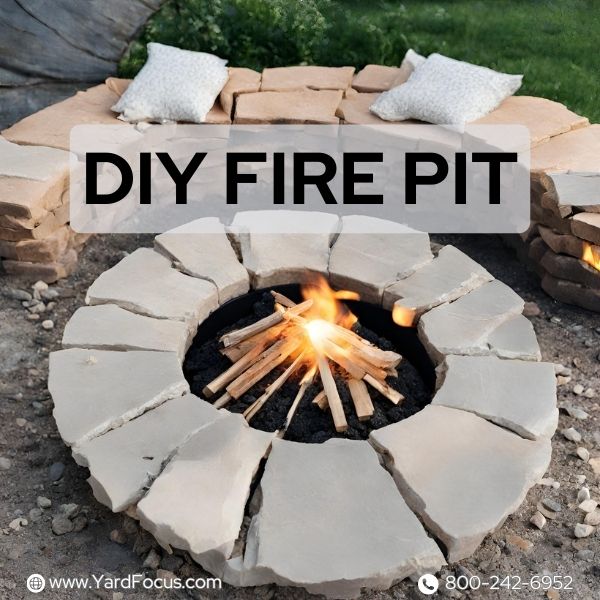
DIY Fire Pit
A DIY fire pit will create cozy outdoor spaces for gathering with friends and family.
Building your own fire pit is a rewarding DIY project. This guide provides step-by-step instructions to construct a custom fire pit from scratch.
Get ready to enjoy warm evenings around a crackling fire!
Planning and Choosing the Right Materials for Your DIY Fire Pit
When planning a DIY fire pit, choose materials carefully. Consider the fuel source, size, and ideal depth.
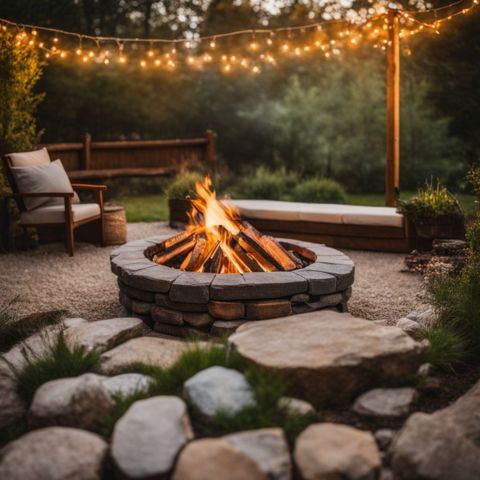
Fuel Sources
Fuel sources determine the fire pit's performance, heat output, and ambiance. Wood is a classic choice, offering a rustic charm and crackling sounds. Fire logs provide convenience, burning cleanly with minimal smoke.
Charcoal yields intense heat, making it ideal for cooking. Gel fuel canisters offer a modern, smokeless flame, perfect for urban settings.
Each fuel has pros and cons. Wood requires tending, produces smoke, and leaves ash. Fire logs are easy but costly long-term.
Like all combustion processes, using charcoal produces carbon monoxide, so ensure proper ventilation; its intense heat is ideal for cooking.
Gel canisters are clean but lack the traditional campfire experience.
Strictly avoid the use of gasoline or other flammable liquids to ignite or rekindle fires due to the high risk of uncontrollable fire spread and personal injury.
Fire Pit Size
A crucial aspect to consider is the fire pit size, as it impacts safety, compliance with local regulations, and the overall enjoyment of the fire pit.
An interior diameter between 3 and 4-1/2 feet is typically ideal, but always verify local guidelines before finalizing your fire pit's dimensions to ensure compliance and safety.
This dimension provides ample space for a blazing fire while facilitating comfortable conversation around the pit.
Choosing the right size ensures a functional and enjoyable fire pit experience.
Building codes and homeowner association rules often regulate fire pit dimensions. Verify local guidelines before finalizing the size.
Selecting an appropriate size not only enhances safety but also optimizes the fire pit's functionality within your backyard space.
Ideal Depth
Transitioning from the ideal fire pit size, determining the appropriate depth plays a crucial role.
Deeper pits may retain heat better but can reduce visibility, while shallower pits enhance visibility and ease of use but may not contain sparks as effectively.
This standard depth also facilitates airflow, promoting efficient combustion while keeping the fire contained.
Moreover, it allows for easy access when adding or rearranging wood, ensuring a safe and enjoyable experience.
Selecting the Perfect Location for Your Fire Pit
Choosing the right spot is crucial for a safe and enjoyable fire pit experience.
Consider local regulations, wind patterns, and proximity to structures or vegetation.
Always consult local regulations for specific distances, but as a general rule, position it at least 10 and 20 feet away from any combustible materials, including overhanging trees, fences, or buildings.
Always consult with local fire safety guidelines to determine the appropriate placement for your fire pit.
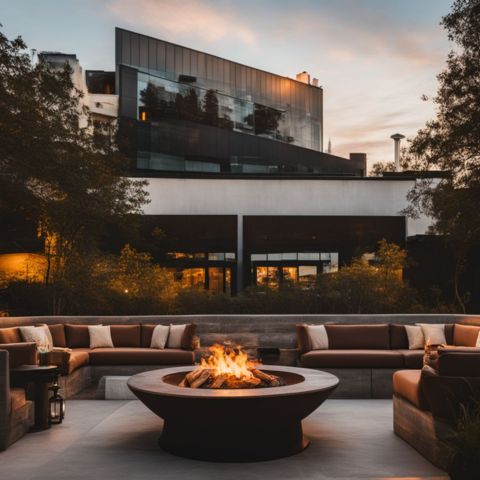
Avoid areas with low-hanging power lines or underground utilities.
Opt for a level, well-drained area, preferably with a non-combustible surface like gravel or paving stones.
Safety should be the top priority. Ensure the fire pit location has adequate clearance from any potential hazards.
Assess the wind direction and plan for smoke dissipation. Avoid placing the fire pit in an enclosed space or under a covered patio, as proper ventilation is essential.
Consider adding seating or patio furniture around the perimeter for a comfortable gathering, but maintain a safe distance from the fire pit itself.
Steps to Building a DIY Fire Pit
Steps to building a DIY fire pit involve selecting the shape, installing the paver base, choosing fire pit fillers, setting stones, and installing fire bricks.

Read on for an in-depth guide to creating your dream backyard fire pit.
https://www.youtube.com/watch?v=1EOUJUyBXRQ
Selecting the Shape
Selecting the shape is a crucial decision when building a DIY fire pit. Round fire pits create a cozy, intimate ambiance.
They allow for an equal seating arrangement around the fire. Square or rectangular fire pits offer a modern, clean look.
They complement contemporary outdoor spaces well. Consider your patio or backyard design when choosing the shape.
Another shape option is a curved fire pit. These provide a stylish, sculptural focal point.
Curved fire pits blend organic and geometric forms seamlessly. They suit various landscaping styles, from rustic to modern.
Installing the Paver Base
A paver base protects the ground. It provides a stable foundation for the fire pit. Installing a paver base is essential.
It distributes the fire pit's weight evenly. The paver base prevents sinking or shifting.
Proper installation contributes to the fire pit's longevity and durability.
The paver base is crucial for constructing a safe, functional fire pit. It ensures the safety and stability of the fire pit.
This is an essential step in the DIY fire pit building process.
Selecting Fire Pit Fillers
After installing the paver base, choose suitable fire pit fillers such as gravel, lava rocks, or fire-rated sand, which are valued for their heat resistance, drainage properties, and safety.
Gravel provides drainage, while lava rocks resist high temperatures.
Fire-rated sand also withstands intense heat. These fillers protect the base and create a stable foundation for the fire pit ring or firebrick lining.
Ensure all fillers used are fire-rated or specifically designated for high-heat applications to prevent the risk of cracking or explosions, enhancing the safety of your fire pit.
Stone Setting
For stone setting, place fire-rated bricks around the pit's perimeter. Employ construction adhesive to secure the bricks firmly.
Maintain a consistent pattern for an attractive appearance.
Opt for heat-resistant stones like fire-rated bricks. Arrange them neatly, ensuring they form a complete circle.
Utilizing construction adhesive enhances durability and safety.
Fire Brick Installation
The installation of the fire brick is crucial. Fire bricks withstand intense heat, preventing damage. Install them using construction adhesive after the paver base.
Choose fire-rated bricks for long-lasting results.
Installing fire bricks correctly ensures safety. These specialized bricks line the fire pit interior. They protect other materials from burning.
Adhering them firmly with construction adhesive is vital.
Select fire bricks that meet heat-resistance standards. Proper installation creates a durable fire pit.
DIY Fire Pit Ideas
DIY fire pit ideas include easy fire pits with pavers, repurposed DIY fire pits, modern-style DIY metal and glass fire pits, DIY mini fire pits, DIY square fire pits, and DIY fire pit patios.
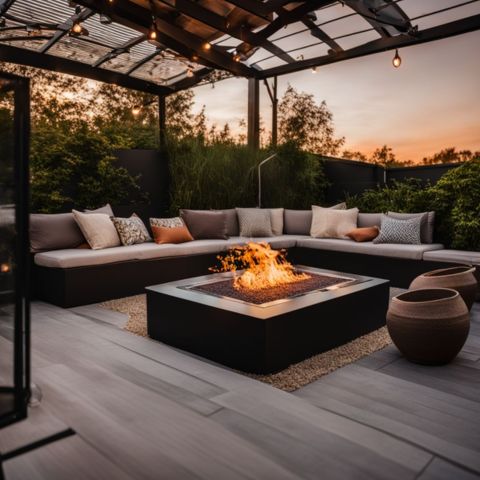
Always prioritize safety by having a fire extinguisher or water source nearby when the fire pit is in use, and never leave the fire unattended.
Ensure your fire pit design includes features for emergency extinguishment.
Check out these creative options to build your own unique backyard fire pit.
Easy Fire Pit With Pavers
One simple DIY fire pit option involves using pavers. This approach creates a stable, contained space for your backyard fire.
Arrange the pavers in a circle, overlapping the joints for added stability.
The paver ring defines the fire pit's perimeter, preventing the fire from spreading.
Another advantage of using pavers is their versatility. You can customize the fire pit's size and shape to suit your needs.
Incorporate decorative elements like colored or patterned pavers for an attractive focal point in your outdoor space.
Repurposed DIY Fire Pit
A repurposed DIY fire pit offers a creative and eco-friendly way to build your backyard oasis.
Utilizing recycled materials like old metal drums, wheelbarrows, or even washing machine tubs, you can construct a unique fire pit that adds character to your outdoor space.
Repurposing also helps reduce waste and gives new life to discarded items.
For a rustic touch, consider incorporating materials like bricks or stones salvaged from demolition sites or flea markets.
This approach not only saves money but also promotes sustainable living.
Modern-Style DIY Metal and Glass Fire Pit
For a sleek and contemporary look, consider building a modern-style DIY fire pit using metal and glass materials.
These fire pits feature stylish metal frames and glass panels, creating a unique and eye-catching design.
Choose heat-resistant metals and tempered glass to ensure safety and durability.
Incorporate clean lines, geometric shapes, and minimalist elements for a chic and sophisticated aesthetic.
This type of fire pit adds a touch of elegance to any outdoor space. The next section covers DIY mini fire pits.
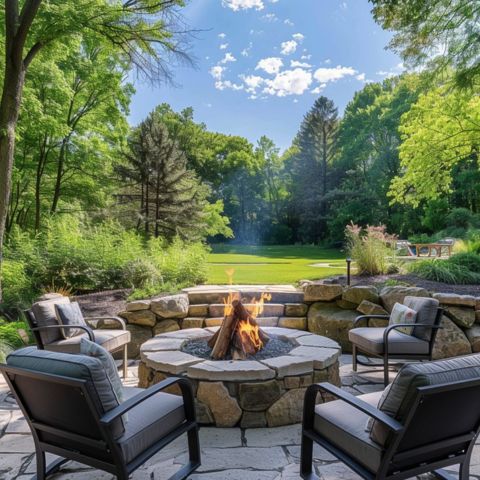
DIY Mini Fire Pit
DIY mini fire pits offer an affordable way to create a cozy ambiance in your backyard.
These compact fire pits can cost between $50 and $150 and are fueled by gel canisters, pressed wood logs, real wood logs, or charcoal.
Various DIY ideas exist, such as using concrete landscaping stones and a metal fire pit ring.
Combine your mini fire pit with benches, tables, or s'mores bar carts for a stylish backyard fire pit space.
DIY Square Fire Pit
A square fire pit offers a contemporary and sleek design. Build it with retaining wall blocks for a rustic look.
Use a fire pit kit for easy construction. Square pits accommodate various fuel sources like wood, fire logs, charcoal, and gel canisters.
They provide a cozy backyard atmosphere at a budget-friendly cost.
Call 811 before digging to build a DIY square fire pit. Utility lines must be marked on your property.
This ensures safety during construction. Next up: DIY Fire Pit Patio.
DIY Fire Pit Patio
DIY fire pit patios combine the warmth and ambiance of an outdoor fire pit with a paved seating area, creating a cozy and inviting space.
These patios often feature a central fire pit surrounded by paved surfaces like brick, stone, or concrete pavers.
Incorporating built-in seating or placing outdoor furniture around the fire pit area enhances the functionality and comfort of the space.
DIY fire pit patios offer a practical and visually appealing solution for outdoor entertaining, allowing homeowners to enjoy the crackling flames while socializing with friends and family.
Constructing a DIY fire pit patio involves planning the layout, selecting suitable paving materials, and adhering to local regulations regarding outdoor fire features.
Proper drainage and a sturdy base are essential for longevity.
FAQs
What tools do I need to build a DIY fire pit?
You will need basic tools like a shovel for sod removal, a chisel for shaping the fire pit, and pipes or metal sheets to construct the pit.
Can I use any type of material for the fire pit?
While you can use various materials, clay or fire-resistant bricks are recommended for safety and durability when building a backyard fire pit.
Where should I place the fire pit in my backyard?
Position the fire pit away from trees, buildings, or any flammable structures. Ensure there is enough space for chairs and firewood storage.
How do I start a fire in the DIY fire pit?
Use fire starters or crumpled paper to ignite the firewood. Strictly avoid the use of gasoline or other flammable liquids to ignite or rekindle fires due to the high risk of uncontrollable fire spread and personal injury.
Can I cook food in my DIY fire pit?
Yes, you can cook food in your fire pit, similar to campfires. However, for a better cooking experience, consider building a clay oven or a grill attachment.
Conclusion
A DIY fire pit offers endless opportunities for creating an inviting outdoor space.
Follow the step-by-step guide to construct your own custom fire pit. Gather the required materials and tools.
Select a suitable location by considering safety and local regulations. Build the base with heat-resistant materials.
Customize the design to suit your preferences. Enjoy cozy evenings around the crackling flames.
